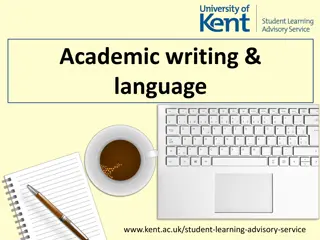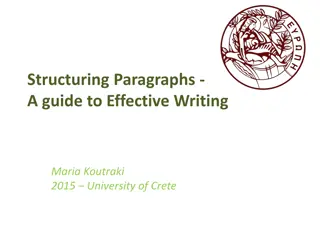Mastering Effective Paragraph Writing
Learn the essential components of an effective paragraph - Claim, Evidence, and Commentary. Discover how to structure paragraphs to enhance your writing and support your arguments effectively. Explore examples to see how these elements can be applied in practice.
Download Presentation

Please find below an Image/Link to download the presentation.
The content on the website is provided AS IS for your information and personal use only. It may not be sold, licensed, or shared on other websites without obtaining consent from the author.If you encounter any issues during the download, it is possible that the publisher has removed the file from their server.
You are allowed to download the files provided on this website for personal or commercial use, subject to the condition that they are used lawfully. All files are the property of their respective owners.
The content on the website is provided AS IS for your information and personal use only. It may not be sold, licensed, or shared on other websites without obtaining consent from the author.
E N D
Presentation Transcript
Effective Paragraphs Effective paragraphs are important in all types of writing. Your paragraphs guide your reader through the paper by helping to explain, substantiate, and support your thesis statement (your argument). Each paragraph should discuss one major point or idea. An effective paragraph has three parts: Claim, Evidence, and Commentary.
Claim This is also sometimes called a topic sentence. This will be your way of announcing the main focus of your paragraph. It should tell the reader what your paragraph will be about what your opinion is. Your claim will be an arguable opinion (stated as fact) that you will "prove" with your evidence.
Evidence This is how you support, or back up, your claims. The evidence will help to "prove" your claim to the reader. The evidence may take the form of a direct quotation, paraphrased material, statistical data, or any other information from your source that helps to support your claim.
Commentary Your commentary is an analysis or concluding observation that is your way of "wrapping up" the information you have presented in your paragraph. It should explain why the evidence supports your claim. It is important to end with your own analysis of the information rather than with evidence. This keeps you "in control" of the paragraph. If you end with evidence, you are emphasizing ideas from your source rather than your own.
Lets go through an example of all three parts together! Question: Is the third little pig very wise in The Three Little Pigs?
Claim In the fairy tale The Three Little Pigs by In the fairy tale The Three Little Pigs by Mother Goose, the third pig is very wise. Mother Goose, the third pig is very wise.
Evidence Bring in textual evidence to support your CLAIM. Text Evidence = facts, quotes, examples, etc. from text Embed your evidence: Each piece of quoted material in a paragraph must have an introduction that gives the context and background for the quotation. Embedding quotations helps quoted material flow naturally and coherently into your paragraph.
Evidence Remembering his mother s warning about a wolf, he builds his house out of sturdy brick. The sentence begins with an introduction, and there is a quotation from the actual story that flows with the context of our answer. Listen to It! When written properly, the reader should not be able to hear where the quotation marks are when the sentence is read aloud. A properly embedded quotation creates a seamless transition from the background information to the quoted material.
Evidence You may need to change words within your quote so that the sentence is grammatically correct and coherent. When changing words in a sentence, indicate the change by placing brackets [ ] around the change in the word or the changed word. The original line in the story is builds his house out of sturdy brick but if you need to use past tense, adjust the verb to make it flow and be grammatically correct. The third little pig decided to [build] his house out of sturdy The third little pig decided to [build] his house out of sturdy brick when he remembered his mother s warning about a wolf. brick when he remembered his mother s warning about a wolf.
Evidence You may need to omit a word or words in the middle of a long quotation to condense it or embed it into your thoughts. To omit words, use ellipses ( ) The writer removed parts of the text and changed he to the wolf and but he to and in order for the evidence to make sense and flow within the sentence. Learning from his brothers mistakes, he built his house out Learning from his brothers mistakes, he built his house out of sturdy bricks and [the wolf] huffed and puffed [and] of sturdy bricks and [the wolf] huffed and puffed [and] couldn't blow this third little pig's house down. couldn't blow this third little pig's house down.
Commentary Connect your evidence to the answer Start your sentence with a reiteration (or summary) of what is happening in the quotation. Be specific. Explain how the text evidence supports your answer. By building his house out of brick, the third pig By building his house out of brick, the third pig demonstrates that he is smarter than his brothers, who demonstrates that he is smarter than his brothers, who built their homes out of straw and sticks, because the built their homes out of straw and sticks, because the wolf was unable to destroy his property. wolf was unable to destroy his property.
Lets Put it Together! Prompt: Is the third little pig very wise in The Three Little Pigs? In the fairy tale The Three Little Pigs, the third pig is very wise. Remembering his mother s warning about a wolf, he builds his house out of sturdy brick. By building his house out of a stronger material, the third pig demonstrates that he is smarter than his brothers, who built their homes out of straw and sticks, because the wolf was unable to destroy his property.
Crossover Question These questions require the student to make a connection between thematically paired texts. You will need text evidence from BOTH selections Use the same C-E-C strategy with a twist C E1 E2 C C: Answers the question as it pertains to BOTH selections E1: Brings in quotation(s) from the first selection E2: Brings in quotation(s) from the second selection C: Connects BOTH pieces of evidence to the answers
Why do students score a 1? The third little pig is wise because he built his house out The third little pig is wise because he built his house out of brick. of brick. The student does not understand the difference between a general text reference and text evidence. The third little pig is wise because he built his house out The third little pig is wise because he built his house out of brick and the wolf couldn t blow it down even though of brick and the wolf couldn t blow it down even though he huffed and he puffed. he huffed and he puffed. The student s choice of text evidence may have some relationship to the idea but does not clearly support it.
Why do students score a 1? The third little pig is very wise because he builds his house out of The third little pig is very wise because he builds his house out of brick and offers shelter to his two brothers whose houses were brick and offers shelter to his two brothers whose houses were blown down by the roof. He also puts a large pot of water on the blown down by the roof. He also puts a large pot of water on the fire for the wolf to fall into when he climbs up the chimney. fire for the wolf to fall into when he climbs up the chimney. The student includes multiple ideas but does not provide textual support for all of them. In the fairy tale The Three Little Pigs , the third little pig is very In the fairy tale The Three Little Pigs , the third little pig is very wise because he is called the wise little pig. wise because he is called the wise little pig. The student includes both an idea and text evidence, but instead of supporting the idea, the text evidence merely repeats, or ECHOES, the idea.
Why do students score a 2? In the fairy tale The Three Little Pigs , the third little In the fairy tale The Three Little Pigs , the third little pig met a man with a load of bricks. The little pig said to pig met a man with a load of bricks. The little pig said to him, "Please, man, give me those bricks to build me a him, "Please, man, give me those bricks to build me a house." This the man did, and soon the little pig had house." This the man did, and soon the little pig had built a house with them which shows that he is wise. built a house with them which shows that he is wise. The student s idea is not as strong as his text evidence. His idea may be too surface-level or too briefly explained to show a deep understanding of the selection.
Why do students score a 2? In the fairy tale The Three Little Pigs , the third little In the fairy tale The Three Little Pigs , the third little pig is very wise because he learns from his brothers pig is very wise because he learns from his brothers examples and builds his house out of brick so the wolf is examples and builds his house out of brick so the wolf is unable to blow his house down. By seeing what his unable to blow his house down. By seeing what his brothers experienced with their homes, the third pig brothers experienced with their homes, the third pig chooses the smartest material to build an indestructible chooses the smartest material to build an indestructible home. home. The student s text evidence does not support the idea strongly enough to show a deep understanding, usually because there is not enough evidence presented.
Why do students score a 3? In the fairy tale The Three Little Pigs, the third pig is very wise. Remembering his mother s warning about a wolf, he builds his house out of sturdy brick. By building his house out of a stronger material, the third pig demonstrates that he is smarter than his brothers, who built their homes out of straw and sticks, because the wolf was unable to destroy his property. Both the student s ideas and choice of textual evidence are strong. It is this combination that demonstrates the student s depth of understanding.























